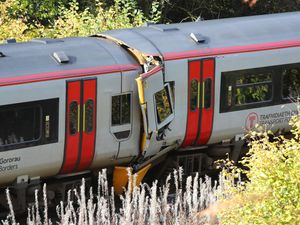Automated system failed ahead of fatal Powys train crash
An interim report has found that an automated system that helps train wheels grip railway tracks failed on a train involved in a fatal crash in mid-Wales last month.
Watch more of our videos on ShotsTV.com
and on Freeview 262 or Freely 565
Passenger David Tudor Evans, 66, died and 11 people were injured, four seriously, when the 1J25 6:31pm Shrewsbury to Aberystwyth service collided with the 1S71 07:09pm Machynlleth to Shrewsbury service just outside of Talerddig loop in Powys on October 21.
Hoses fitted to the Transport for Wales (TfW) train to discharge sand when wheels slide during braking were "blocked", the Rail Accident Investigation Branch (RAIB) has said in its initial findings, published on Tuesday.

The train was travelling at between 15-24mph when it collided head-on with another TfW train travelling at around 6mph.
The RAIB has said has found that 1J25 had been scheduled to stop at Talerddig loop to let 1S71 pass, and the driver of the train correctly applied service braking on the approach to the loop.
The report said: “Both trains involved in the accident were 2-car class 158 diesel multiple units.
“These units are fitted with wheel slide protection systems, similar in function to anti-lock braking systems on road vehicles, and an automatic sanding system, which discharges sand automatically via sanding hoses when wheel slide is detected during braking. This is intended to increase the available friction at the wheel/rail interface.
“RAIB’s preliminary examination has found that westbound train 1J25 had been due to stop in the loop at Talerddig to allow eastbound train 1S71 to pass.
“Initial analysis of data from the on-train data recorder (OTDR) fitted to train 1J25 shows that the driver applied service braking to slow the train as it neared the loop at Talerddig.”
The report said “around 40 seconds” after the first service brake application, the OTDR records the emergency brake being pulled.
“This emergency brake demand remained in place until the collision. OTDR data shows that wheel slide started during service braking and was constant during emergency braking,” the report said.
It continued: “Train 1J25 then entered the loop at Talerddig. Although the train slowed while passing through the loop, it did not stop before passing the block marker positioned near the exit.
“The train subsequently exited the loop, rejoined the single line, and continued to travel for around 900 metres on the descending gradient, before colliding with train 1S71.”
The reports said while neither train derailed in the collision, “significant damage” was caused to the leading vehicles of both trains.
But it added: “There is conflicting evidence relating to the speed of the trains at the point of collision.
“Initial analysis indicates that train 1J25 was travelling at between 24 km/h (15 mph) and 39 km/h (24 mph), while train 1S71 was travelling at around 10 km/h (6 mph) in the opposite direction. RAIB is continuing to analyse evidence relating to the collision speed, which remains an area of ongoing investigation,” the report found.
The RAIB said a full investigation will now consider various points inlcuding the actions of those involved and any factors that may have influenced them, the level of wheel/rail adhesion present from the approach to Talerddig loop, the status and performance of the braking, wheel slide protection and sanding systems on train 1J25, and the behaviour of both trains during and following the collision.
It said it will also look at Transport for Wales and Network Rail’s policies relating to low wheel/rail adhesion and how it managed the risk of low adhesion on the Cambrian line and “any relevant underlying factors, including any actions taken in response to previous relevant safety recommendations”.
In a joint statement, Network Rail and Transport for Wales said: "As investigations are currently still ongoing, we’ll continue to work together with investigators to understand what happened and await the full conclusion and recommendations of the investigation.
"Safety is always our main priority for our customers and colleagues, and we have carried out enhanced checks to the trains and the railway line to enable the reopening of the Cambrian line on Monday 28 October 2024.
"At this early stage of the investigation, it’s fundamental that we await the findings of the full report and show sensitivity towards our customers, colleagues, the local community and the families of those affected by the incident."





